Land is used in many different ways. Some areas have rivers, some are covered with trees, and others are used for roads, buildings, or open spaces. Each type of land is suitable for different purposes. People use land to grow crops, build houses, create parks, and make other useful spaces. For example, fertile land is best for farming, while flat land is ideal for building cities and towns.
Land Resources & Agriculture Land Class 12 Geography
Introduction
Land-Use Categories
Land-Use Records
- The records are maintained by the Land Revenue Department.
- The Reporting Area reflects land-use categories and can change based on land revenue estimates.
- Geographical Area, measured by the Survey of India, is fixed and does not change.
The land-use categories as maintained in the Land Revenue Records are as follows:
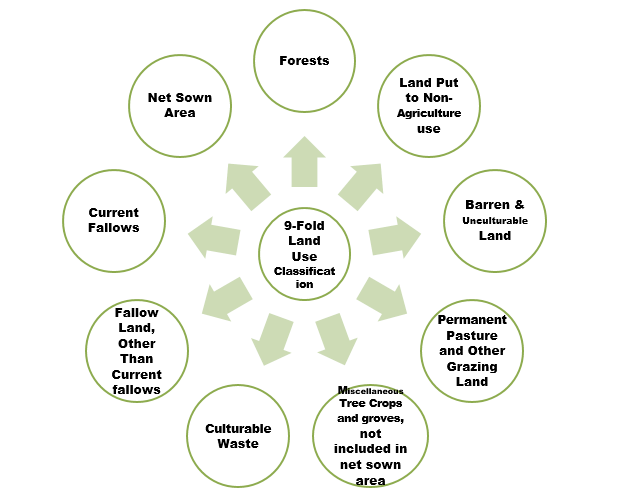
- Forests: Areas marked for growing forests, but they might not always have trees.
- Barren and Wastelands: Includes land that's hard to use, like rocky hills, deserts, and deep ravines.
- Land for Non-Agricultural Uses: Land used for buildings, roads, factories, and shops.
- Permanent Pastures and Grazing Lands: Used for grazing animals, mostly owned by local governments or village councils, with a few privately owned.
- Miscellaneous Tree Crops and Groves: Areas with orchards and fruit trees, usually privately owned.
- Culturable Wasteland: Land that hasn't been used for over five years but can be used again with some work.
- Current Fallow: Land left unused for up to one agricultural year to restore its natural fertility.
- Fallow Other than Current Fallow: Land left unused for more than one year but less than five; if unused for longer, it becomes Culturable Wasteland.
- Net Area Sown: Land where crops are planted and harvested.
Land use Changes in India
Land-use refers to how land is utilized in a region and is significantly influenced by economic activities. As these activities evolve, they create new demands and exert different pressures on land resources.
- Fixed Land Area: The total land area remains constant; it does not increase. As economic activities grow and shift, land use changes to meet new needs, such as converting forests into farmlands or open spaces into urban areas.
- Economic Growth Factors: Driven by an increasing population, rising income levels, and technological advancements. This growth puts more pressure on land resources. For example, expanding cities require more housing, roads, and industries, leading to higher land use.
- Use of Marginal Lands: Expansion often involves using marginal lands previously deemed unsuitable, such as barren or wasteland areas. These lands are repurposed for activities like agriculture, settlements, or industrial purposes.
- Shift from Agriculture: In many economies, especially developing countries like India, the industrial and service sectors grow faster than the agricultural sector. This leads to the gradual conversion of agricultural land into non-agricultural uses, such as factories, offices, and homes, particularly around expanding urban areas.
- Continued Demand for Agricultural Land: Despite a decreasing share of GDP for agriculture, the demand for agricultural land remains high. The number of people relying on agriculture for their livelihood decreases more slowly than the sector’s economic contribution. A growing population requires increased food production, maintaining high demand for agricultural land.
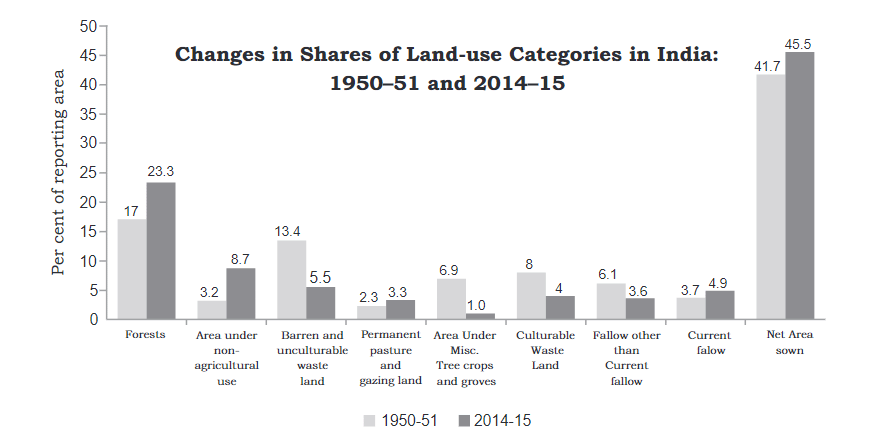 Changes in Shares of Land-use Categories in India: 1950-51 and 2014-15
Changes in Shares of Land-use Categories in India: 1950-51 and 2014-15
In India, from 1950–51 to 2014–15, several land-use categories have shown notable changes:
- Increase in Non-Agricultural Land: The area under non-agricultural uses has risen significantly. Driven by industrial expansion, more infrastructure, and the growth of urban and rural settlements. This often happens at the expense of agricultural land and wastelands.
- Forest Area Expansion: The increase in forest area is mainly due to expanded forest demarcation. This doesn’t necessarily mean there is more actual forest cover.
- Current Fallow Lands: Current fallow lands have increased, often due to fluctuations in rainfall and changes in cropping cycles. These lands are left uncultivated for short periods.
- Net Area Sown: The net area sown has recently increased. This growth is due to the reclamation of previously uncultivated wasteland for agriculture. It reverses earlier declines caused by the conversion of land to non-agricultural uses.
Declines in certain land-use categories include:
- Barren and wasteland areas have decreased due to increased pressure from agricultural and non-agricultural sectors. More of these lands are being utilised for productive or developmental purposes.
- Culturable wasteland has also decreased as these lands are brought into use for agriculture or other purposes, reflecting a growing need for productive land.
- The area under tree crops and groves has reduced due to land conversion for agriculture and other uses, as the pressure to repurpose land for different needs has increased.
- Fallow lands have declined as land is increasingly used for agricultural or other purposes, reflecting broader trends in land utilisation.
Common Property Resources
- Land is classified into private land and common property resources (CPRs) based on ownership.
- Private land is owned by individuals or groups of individuals.
- Common property resources (CPRs) are owned by the state and intended for community use.
- CPRs provide essential resources such as fodder, fuel, and minor forest products like fruits, nuts, fibre, and medicinal plants.
- CPRs are crucial for the livelihoods of landless and marginal farmers who rely on income from livestock due to limited land access.
- Women in rural areas rely on CPRs for collecting fuel and fodder, often spending long hours gathering these resources from degraded areas.
- CPRs are defined as community-owned natural resources where all members have access and usage rights with specific obligations, without individual property rights.
- Examples of CPRs include community forests, pasture lands, village water bodies, and other public spaces managed by groups larger than individual households.
Agricultural Land Use in India
 Composition of Total Cultivable Land in India
Composition of Total Cultivable Land in India
Land resources are crucial to the livelihood of people who depend on agriculture.
Agriculture is purely land-based, with land contributing more to agricultural output compared to other sectors. Lack of access to land correlates with poverty in rural areas.
The quality of land directly impacts agricultural productivity, which is not the case for secondary and tertiary activities.
In rural areas, land ownership not only has economic value but also serves as social security and status, providing a safety net for credit, natural hazards, and life contingencies.
Total stock of agricultural land resources (i.e., total cultivable land) includes net sown area, fallow lands, and culturable wasteland.
Over time, there has been a marginal decline in the total stock of cultivable land as a percentage of total reporting area, with a more significant decline in cultivated land despite a decline in culturable wasteland.
The potential for increasing net sown area is limited, necessitating the development and adoption of land-saving technologies.
These technologies can be categorised into:
- Yield-enhancing technologies: Increase crop yield per unit area of land.
- Land-use intensity technologies: Increase total output per unit area of land from all crops grown in a year, enhancing labour demand.
For a land-scarce but labour-abundant country like India, high cropping intensity is desirable to utilise land efficiently and reduce rural unemployment.
Cropping intensity (CI) is calculated to measure the effectiveness of land use throughout the year.
Formula: Cropping Intensity in percentage = GCA/ NSA × 100
Cropping seasons in India
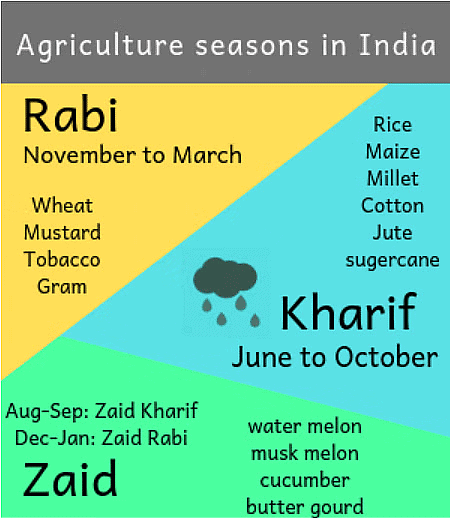
Three distinct crop seasons in the northern and interior parts of the country are kharif, rabi, and zaid.
1. Kharif season
- Coincides with the Southwest Monsoon.
- Suitable for tropical crops such as rice, cotton, jute, jowar, bajra, and tur.
- Begins with winter in October-November and ends in March-April.
- Favourable for temperate and subtropical crops such as wheat, gram, and mustard.
3. Zaid season
- A short-duration summer cropping period follows the harvest of rabi crops.
- Includes crops like watermelons, cucumbers, vegetables, and fodder crops, typically grown on irrigated lands.
Types of Farming
Farming can be classified into irrigated and rainfed (barani) based on the main source of moisture for crops.
1. Irrigated farming is differentiated by its objectives:
- Protective irrigation: Supplements rainfall to prevent soil moisture deficiency, aiming to provide soil moisture over a large area.
- Productive irrigation: Ensures sufficient soil moisture for high productivity, using more water per unit area than protective irrigation.
2. Rainfed farming is classified into:
- Dryland farming: Found in regions with annual rainfall less than 75 cm. Grows drought-resistant crops like ragi, bajra, moong, gram, and guar. Involves soil moisture conservation and rainwater harvesting.
- Wetland farming: Occurs in areas with excess rainfall, leading to potential flood and soil erosion hazards. Grows water-intensive crops like rice, jute, and sugarcane, and involves aquaculture in freshwater bodies.
Foodgrains
- Foodgrains occupy about two-thirds of India's total cropped area and are crucial to the agricultural economy.
- Foodgrains are dominant in both subsistence and commercial agricultural economies.
- These are classified into cereals and pulses.
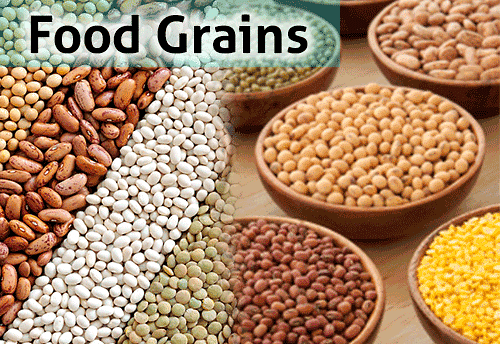
Cereals
- Occupy about 54% of the total cropped area.
- India produces 11% of the world’s cereals, ranking third globally after China and the U.S.
- Classified into fine grains (e.g., rice, wheat) and coarse grains (e.g., jowar, bajra, maize, ragi).
Rice
- Staple food for the majority of India’s population.
- Grown from sea level to 2,000 m altitude.
- Cultivated in both humid areas (e.g., eastern India) and irrigated regions (e.g., Punjab, Haryana).
- West Bengal, Uttar Pradesh, and Punjab are leading producers.
- High yields in states like Punjab, Tamil Nadu, Haryana, Andhra Pradesh, Telangana, West Bengal, and Kerala.
- Low yields in rainfed areas such as Madhya Pradesh, Chhattisgarh, and Odisha.
- Contributes 22.07% of global rice production, ranking second after China.
Wheat
- Second most important cereal crop in India.
- India produces 12.8% of global wheat.
- Cultivated primarily in north and central India during the rabi season.
- Leading states: Uttar Pradesh, Madhya Pradesh, Punjab, Haryana, Rajasthan.
- High yields in Punjab and Haryana (above 4,000 kg/ha).
- Moderate yields in Uttar Pradesh, Rajasthan, and Bihar.
- Low yields in rainfed regions like Madhya Pradesh, Himachal Pradesh, and Jammu and Kashmir.
Jowar
- Accounts for about 5.3% of the total cropped area.
- The main food crop in semi-arid regions of central and southern India.
- Leading producer: Maharashtra.
- Other producers: Karnataka, Madhya Pradesh, Andhra Pradesh, Telangana.
- Sown in both kharif and rabi seasons in southern states; mostly a kharif crop in northern India.
- Low yields south of Vindhyachal.
Bajra
- Grown in hot and dry conditions in northwestern and western India.
- Resilient to drought and dry spells.
- Accounts for about 5.2% of total cropped area.
- Leading producers: Rajasthan, Maharashtra, Gujarat, Uttar Pradesh, Haryana.
- Recent yield increases due to drought-resistant varieties and expanded irrigation.
Maize
- Occupies about 3.6% of total cropped area.
- Grown in semi-arid conditions and inferior soils.
- Leading producers: Karnataka, Madhya Pradesh, Bihar, Andhra Pradesh, Telangana, Rajasthan, Uttar Pradesh.
- Higher yields in southern states, lower yields in central India.
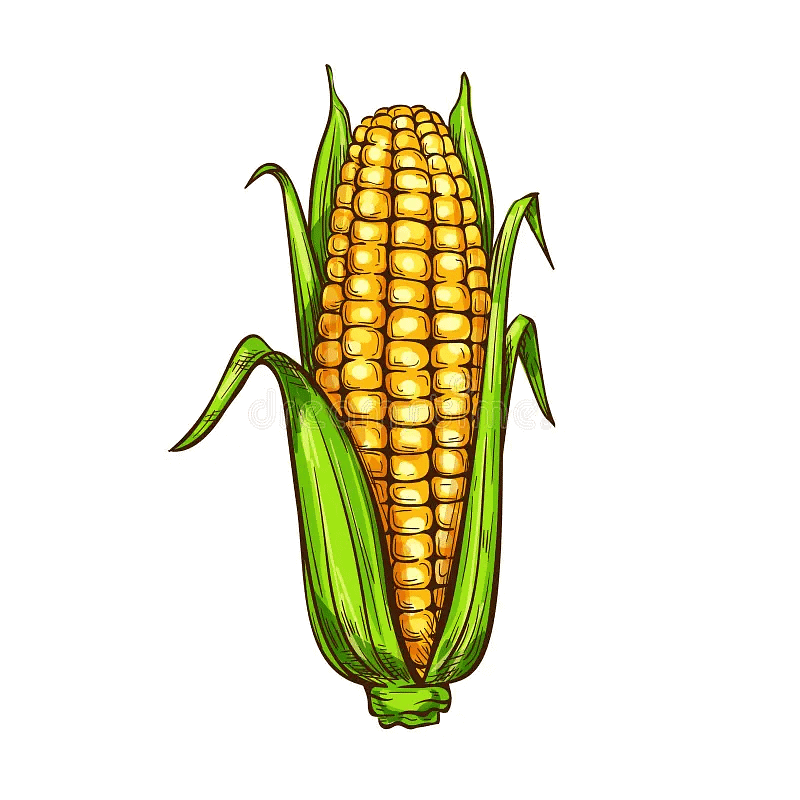 Pulses
Pulses
- Important for protein in vegetarian diets.
- Improve soil fertility through nitrogen fixation.
- India is a leading producer of pulses, which occupy about 11% of total cropped area.
- Cultivated primarily in drylands of the Deccan, central plateaus, and northwestern regions.
Gram
- Cultivated in subtropical areas during the rabi season.
- Grown mainly in Madhya Pradesh, Uttar Pradesh, Maharashtra, Andhra Pradesh, Telangana, Rajasthan.
- Covers about 2.8% of total cropped area.
- Low and fluctuating yields, even in irrigated areas.
Tur (Arhar)
- Also known as red gram or pigeon pea.
- Grown on marginal lands under rainfed conditions in dry areas.
- Occupies about 2% of total cropped area.
- Major producer: Maharashtra (one-third of total production).
- Other leading states: Uttar Pradesh, Karnataka, Gujarat, Madhya Pradesh.
- Low per hectare output and inconsistent performance.
Oilseeds
- Oilseeds are produced for extracting edible oils.
- They occupy about 14% of total cropped area in India.
- Major growing regions include Malwa Plateau, Marathwada, Gujarat, Rajasthan, Telangana, Rayalaseema (Andhra Pradesh), and Karnataka Plateau.
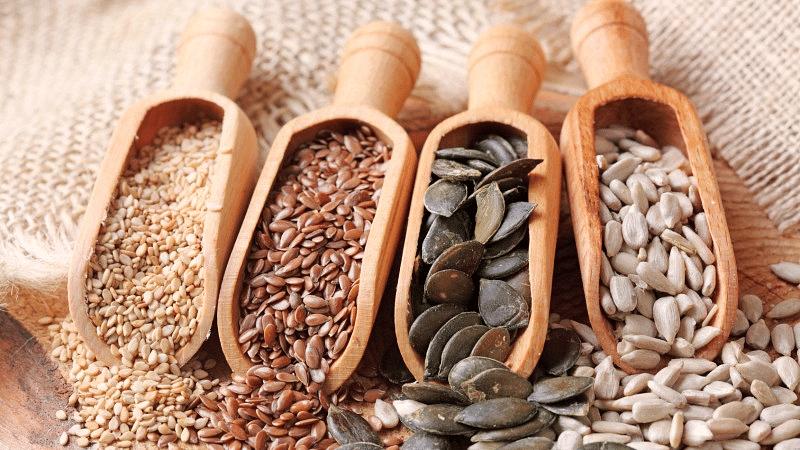
Groundnut
- India produces 18.8% of the world’s groundnut (2018).
- Primarily a kharif (rainfed) crop, but also grown during rabi in southern India.
- About 3.6% of total cropped area
- Gujarat, Rajasthan, Tamil Nadu, Telangana, Andhra Pradesh, Karnataka, Maharashtra are the leading producers.
Rapeseed and Mustard
- Includes rai, sarson, toria, and taramira.
- Subtropical crops grown during rabi season in northwestern and central India.
- Frost sensitive; yields fluctuate yearly.
- Increased with irrigation and better seed technology.
- It covers about 2.5% of total cropped area.
- Rajasthan (one-third production), Haryana, Madhya Pradesh are the leading producers
Other Oilseeds
Soybean
- Predominantly grown in Madhya Pradesh and Maharashtra.
- These states contribute about 90% of the total soybean output in India.
Sunflower
- Cultivation: Concentrated in Karnataka, Andhra Pradesh, Telangana, and adjoining areas of Maharashtra.
- Regional Significance: Minor crop in the northern parts of the country.
Fibre Crops
Fibre crops are those that are cultivated for the purpose of producing fibre used for making cloth. Some of the major fibre crops in India include
Cotton
- Tropical crop, mainly grown in kharif season.
- India grows both short staple (Indian) and long staple (American) cotton.
- Major producers: Gujarat, Maharashtra, Telangana.
- High yields in irrigated areas; low yields in rainfed regions.
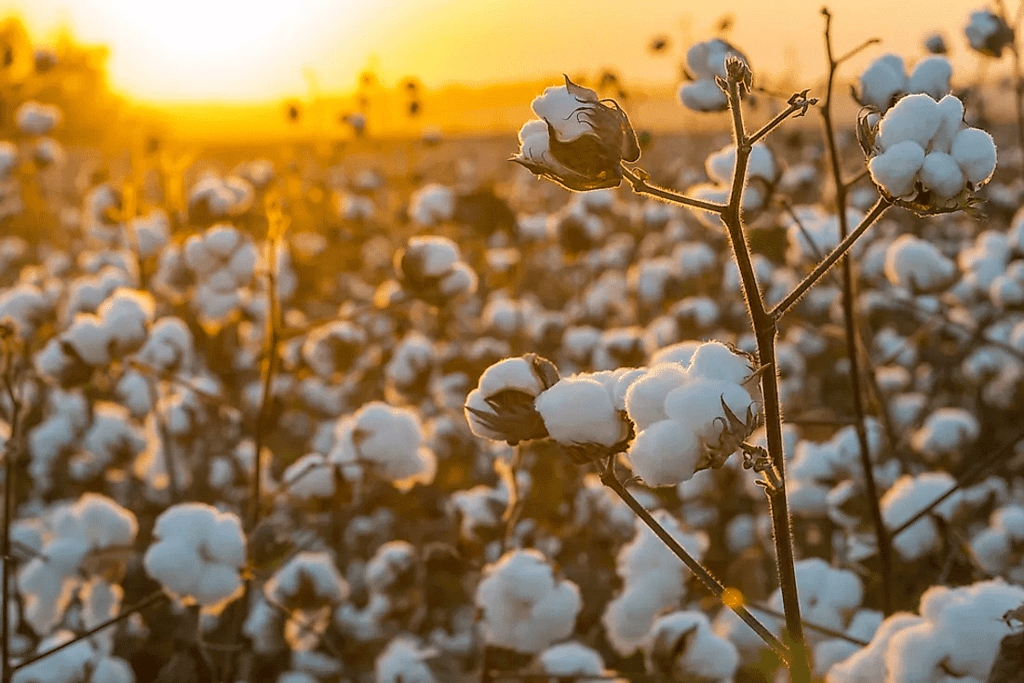
Jute:
- Used for making coarse cloth, bags, sacks.
- Major producer: West Bengal (accounts for about 75% of production).
- Other producers: Bihar, Assam.
- Accounts for only 0.5% of total cropped area.
Other crops
Sugarcane
- Tropical crop, primarily grown in irrigated conditions.
- Major producing states: Uttar Pradesh (largest producer), Maharashtra, Karnataka, Tamil Nadu, Andhra Pradesh.
- India ranks second in the world for sugarcane production.
- Accounts for about 19.7% of global production.
Tea
- Grown in hilly areas with humid and sub-humid conditions.
- Major producing regions: Assam (accounts for 53.2% of production), West Bengal, Tamil Nadu.
- India ranks second in global tea production and export.
Coffee
- Tropical plantation crop, with varieties like arabica and robusta.
- Major producing states: Karnataka (accounts for over two-thirds of production), Kerala, Tamil Nadu.
- India produces about 3.17% of the world’s coffee, ranking eighth globally.
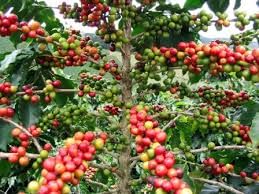
Agricultural Development in India
- Indian agriculture was mainly subsistence-based and faced significant challenges, including frequent droughts and famines. The partition of India led to the loss of a substantial portion of irrigated land, impacting agricultural productivity.
- After gaining independence, the Indian government aimed to increase foodgrain production through several measures, including shifting focus from cash crops to food crops, intensifying cultivation on existing land, and expanding cultivated areas.
- Despite initial progress, agricultural production stagnated in the late 1950s. The situation worsened due to consecutive droughts in the mid-1960s, leading to a food crisis and necessitating foodgrain imports.
- In response to the crisis, high-yielding varieties (HYVs) of wheat and rice were introduced in the 1960s, along with the use of chemical fertilisers and improved irrigation practices. This led to a significant increase in foodgrain production and marked the beginning of the Green Revolution.
- The Green Revolution made India self-reliant in food production and spurred the development of agro-inputs and agro-processing industries. Initially, it was confined to irrigated areas, leading to regional disparities. Over time, the technology spread to Eastern and Central India.
- In the 1980s, the Planning Commission focused on agriculture in rainfed areas and promoted agro-climatic planning for balanced regional development. The 1990s introduced liberalisation and a free market economy, further influencing agricultural development.
Growth of Agricultural Output and Technology
- Agricultural output and technology have significantly improved over the past 50 years.
- Production and yield of crops such as rice and wheat have increased impressively, with notable rises in the production of sugarcane, oilseeds, and cotton.
- Expansion of irrigation has been crucial for enhancing agricultural output, facilitating the introduction of modern agricultural technology like high-yielding varieties, chemical fertilizers, pesticides, and farm machinery. The net irrigated area has also expanded.
- Modern agricultural technology has rapidly spread across various regions, with the consumption of chemical fertilisers increasing by 15 times since the mid-1960s. Due to the susceptibility of high-yielding varieties to pests and diseases, the use of pesticides has also risen significantly since the 1960s.
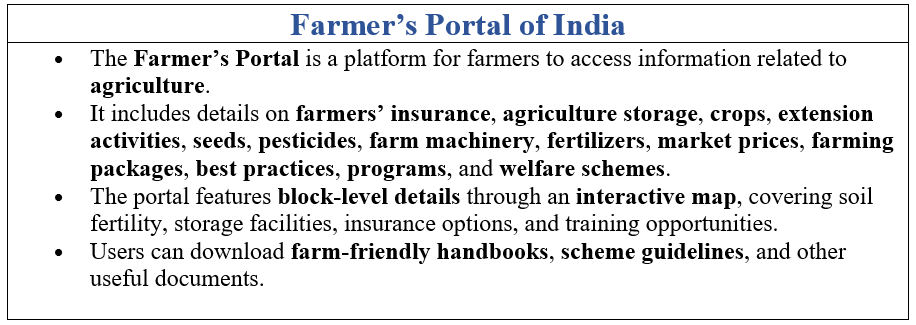 Farmer's Portal of India
Farmer's Portal of India
Problems of Indian Agriculture
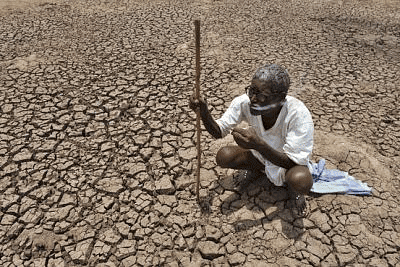
Problems in Indian agriculture vary by region due to different agro-ecological and historical experiences. Some issues are common across regions. A detailed discussion on these problems follows:
Dependence on Erratic Monsoon
- Irrigation covers only 33% of cultivated land in India.
- The remaining land relies on rainfall, which is often unreliable.
- Areas like Rajasthan, Maharashtra, and Gujarat face extreme drought conditions, while other regions experience floods.
- Flash floods and droughts are common, creating instability in agricultural productivity.
Low Productivity
- Crop yields in India are significantly lower compared to global standards, such as those in the USA, Russia, and Japan.
- The per-hectare output of crops like rice, wheat, cotton, and oilseeds is notably lower in India.
- High pressure on land resources and low labour productivity contribute to overall low productivity.
- Rainfed areas, especially in drylands, produce coarse cereals, pulses, and oilseeds with low yields due to limited water and harsh conditions.
Constraints of Financial Resources and Indebtedness
- Modern agricultural inputs such as seeds, fertilisers, and machinery are costly.
- Marginal and small farmers often lack the financial resources to invest in these inputs, leading to reliance on credit from institutions and moneylenders.
- Crop failures and low returns from agriculture force farmers into a cycle of debt.
- Severe indebtedness is linked to farmers' suicides, reflecting the gravity of financial stress in agriculture.
Lack of Land Reforms
- Historical exploitation under British revenue systems (Mahalwari, Ryotwari, Zamindari) left a legacy of unequal land distribution.
- Land reforms were prioritised post-Independence but poorly implemented due to political resistance.
- Inadequate reform efforts have perpetuated inequitable land distribution, impeding agricultural development and equity.
Small Farm Size and Fragmentation of Landholdings
- The average size of landholdings is decreasing under population pressure.
- Many landholdings are fragmented, making agriculture less efficient.
- Consolidation of holdings has not been effectively carried out in many states, leading to uneconomic small plots.
- The process of division among generations has further fragmented land, exacerbating the problem.
Lack of Commercialisation
- Many farmers produce primarily for self-consumption, lacking the resources to focus on market-oriented production.
- Small and marginal farmers often grow enough only to meet their own needs.
- Commercialisation and modernisation have been mainly limited to irrigated areas, while large parts of India remain subsistence-based.
Vast Underemployment
- There is significant underemployment in agriculture, especially in unirrigated regions.
- Seasonal unemployment can last from 4 to 8 months annually.
- Even during the cropping season, agricultural work is not consistently available due to the low labour intensity of many operations.
Degradation of Cultivable Land
- Faulty irrigation practices have led to degradation of land, including alkalisation, salinisation, and waterlogging.
- Excessive use of chemical fertilizers and pesticides has caused toxic accumulation in the soil.
- Soil fertility is declining due to reduced natural nitrogen fixation and shorter fallow periods.
- Rainfed areas face soil erosion due to human activities like deforestation and improper land management.
Conclusion
The dynamics of land use in India highlight the balance between growth and sustainability. As urban expansion, industrialization, and technological advancements shape land use patterns, the challenge remains to manage these changes while preserving essential agricultural and ecological resources. Understanding these patterns helps address the complexities of land management and guides future planning to ensure sustainable development.
|
50 videos|366 docs|37 tests
|
FAQs on Land Resources & Agriculture Land Class 12 Geography
| 1. What are the different land use categories in India? |  |
| 2. What are common property resources in the context of land resources and agriculture? |  |
| 3. What are the different cropping seasons in India? |  |
| 4. What are the types of farming practices followed in India? |  |
| 5. What are some of the key problems faced by Indian agriculture? |  |

















